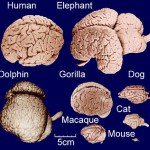Marine Mammals
I've got a new piece over at the Scientific American Guest Blog:
On Friday, March 11, Japan was rocked by an earthquake. People were displaced, a nuclear reactor was in trouble, and the world watched as a tsunami flooded Japan, threatened the islands of the Pacific, and ultimately hit the western coasts of North and South America. Chris Rowan pointed out that "Very little of the devastation resulting from this earthquake was from the initial shaking. This is partly because of Japan's stringent building codes. But mainly because any damage from the seismic waves that sent skyscrapers in Tokyo…
Eric M. Johnson and I spent about 45 minutes discussing "evolutionary psychology beyond sex" last night, which you can see today on Bloggingheads "Science Saturday."
Or just watch it here:
Scientists thought they had a pretty good handle on the social interactions of bottlenose dophins (Tursiops). They've used the term fission-fusion dynamics to describe dolphin (and non-human primate) society and so far it has served researchers well. Fission-fusion societies among dolphins are characterized by two levels of social hierarchy: groups of two or three related males ("first-order alliances") which work together to guard one or more females from other males, and larger teams comprised of multiple related first-order alliances ("second-order alliances") which cooperate to "steal"…
Meet Rio.
Rio is a California Sea Lion (Zalophus californianus). She was born in captivity at Marine World in Northern California, and due to insufficient maternal care from her biological mother, she was transferred to the Long Marine Laboratory at UC Santa Cruz when she was just a few days old. There, she was raised by a human surrogate mother, in the context of an imprinting study. She's got a pretty good life. She gets all the fish she could want, and has 3 other pinniped (seals, sea lions, otters) friends at the lab. There's Burnyce, a female Northern elephant seal, Sprouts, a male…
Here at The Thoughtful Animal, we are conducting series of seven-question interviews with people who are doing or have done animal research of all kinds - biomedical, behavioral, cognitive, and so forth. Interested in how animal research is conducted, or why animal research is important? Think you might want to do some animal research of your own someday? This is the interview series for you.
Andrew Thaler (twitter, blog) is pursuing a doctorate in the marine biology at the Duke University Marine Lab. He is especially interested in population genetics in hydrothermal vent communities. He is…
The National Institutes of Health announced that by 2011 it will transfer almost two hundred chimpanzees from the Alamogordo Primate Facility in New Mexico to a lab in San Antonio, Texas, lab for use in invasive research. In 1995, the NIH announced a moratorium on the breeding of chimps in federally-supported labs, and as a result, scientists have developed alternative ways to investigate diseases. But there are still viruses, such as hepatitis C and HIV, that other species simply can't contract. This fact, some argue, makes it prudent to subject chimps to this sort of biomedical testing.…
Several weeks ago, BBC Earth contacted me to let me know about this awesome new website they were building: Life Is.
The website, created by Firefly Interactive and The Brooklyn Brothers, will showcase some of the best images, videos and stories that the BBC Earth Natural History Unit has accrued in over 50 years of expeditions.
From the recent Life to the ground-breaking Life on Earth, BBC Earth has been at the forefront of our desire to discover more about our planet. The site, Life Is, fully compliments this back catalogue of programming enabling the viewer to see the content as it was…
tags: The Intriguing Sound of Marine Mammals, sounds, songs, communication, language acquisition, noise pollution, shipping, acoustic environment, vocal imprinting, marine mammals, dolphins, whales, Peter Tyack, TEDTalks, TED Talks, streaming video
Bird watchers (especially those who do most of their birding by ear) will particularly enjoy this video: Peter Tyack of Woods Hole talks about a hidden wonder of the sea: underwater sound. Onstage at Mission Blue, he explains the amazing ways whales use sound and song to communicate across hundreds of miles of ocean.
TEDTalks is a daily video…
Yesterday afternoon, I watched the livestream of the "All Creatures Great and Smart" session of the World Science Festival in New York City. The session was absolutely fantastic, and featured Brian Hare, Vanessa Woods, Jeremy Niven, Patrick Hof and Klaus Zuberbühler.
The conversation challenged long-held assumptions about the differences between "animal" and "human", and included fascinating discussion about pin-sized brains that can count, categorize, and hold a grudge against those who've tried to swat them. Does your dog really think and feel like a human? Do our closest primate…
tags: ecology, marine biology, conservation biology, endangered species, environmental toxicology, seabirds, marine mammals, researchblogging.org,peer-reviewed research, journal club
Bird rescue personnel Danene Birtell (L) and Heather Nevill (R) hold an oiled brown pelican, found on Storm Island in the Gulf of Mexico off the coast of Louisiana, that will be washed at the treatment facility at Fort Jackson, Louisiana, USA. BP has contracted bird rescue groups to rehabilitate wildlife affected by the Deepwater Horizon oil spill. The birds are examined, thoroughly washed and then allowed to…
tags: Brian Skerry Reveals Ocean's Glory -- and Horror, conservation, marine biology, fish, marine mammals, oceans, sharks, leatherback sea turtle, right whale, overfishing, photographer, Brian Skerry, TEDTalks, TED Talks, streaming video
Professional photographer Brian Skerry shoots life above and below the waves -- as he puts it, both the horror and the magic of the ocean. Sharing amazing, intimate shots of undersea creatures, he shows how powerful images can help make change.
TEDTalks is a daily video podcast of the best talks and performances from the TED Conference, where the world's…
The perspective that whales, dolphins, and other such marine mammals should be afforded "human rights" has surfaced again.
I thought I'd revisit a post I wrote about this several months ago, from the archives, when this first hit the news after the AAAS conference in San Diego. So here's a modified, updated version of the original post.
The blogosphere is all a-twitter with talk of the recent commentary in Science that dolphins should be considered people. Well, sort of people. Non-human people.
On the heels of the incident at SeaWorld in Florida in which a trainer was killed by one of the…
Want to get experience working with marine mammals? The Dolphin Research Center, in Grassy Key, Florida, is looking for interns for the Fall semester, and the deadline to apply is next week!
The DRC is home to a pod of Atlantic bottlenose dolphins (you might recognize A.J. from my banner image, used with permission of course) and a group of California sea lions. While the DRC hasn't yet been hit by oil from the BP oil spill, they are monitoring the situation closely - this may be a great opportunity to learn a ton about marine mammal research and help in the conservation effort.
Check out…
Four sea lions nicknamed Matti, Pablo, Apolo and Taite were recently found underweight and malnourished on beaches in Orange County. This morning, they were released back into the wild before a cheering crowd at Crescent Bay in Laguna Beach. This was possible due the incredible work of the Pacific Marine Mammal Center, a non-profit organization dedicated to the rescue, rehabilitation, and release of marine mammals stranded along the Orange County coastline.
And check out how positively THRILLED the animals seem to be to get back into the water. Let's hope they re-adjust to life at sea…
Though they are routinely found in the waters off of California, large marine mammals like killer whales don't usually come so close to shore - it seems they prefer to stick to the farther side of the channel islands.
But yesterday, a small pod of killer whales was found in the waters between Palos Verdes and Santa Catalina Island.
KABC-TV had some nice footage of the pod:
Can't see this embedded video? Click here to watch!
Amazing that this comes on the same day that a lone grey whale was spotted in the Mediterranean Sea, off the coast of Tel Aviv!
(h/t: LAist)
Earlier this week we talked about how to use whale snot for science.
I especially enjoyed blog bff Scicurious's take on the study:
Budgetary requirement: $5000 for series of expensive remote control helicopters.
Source: Toys R Us.
Justification: Need something that can fly close to a whale and collect snot for measurement. Also, this is the only kind that comes in red, and the gunmetal grey ones suck.
This day, however, we will travel farther, er, south. Through the mouth, down the esophagus, into the stomach, detour through the intestines, take a left at the sphincter, but, what, what's…
Figure 1: Humpback whale
The question is: what do you use to study the health of whales in the wild?
The answer is: not what you'd think.
Unlike smaller sea mammals like seals or sea lions, it is very hard to obtain blood samples from whales without first killing them.
Meet Karina Acevedo-Whitehouse, from the Zoological Society of London. She studies whale health, but has had to rely on dead, stranded or captive animals for blood samples, which are hardly representative of whales in the wild.
Figure 2: Dr. Karina Acevedo-Whitehouse
So what's the next best thing to whale blood? Well, SNOT,…
tags: white orca, white killer whale, Orcinus orca, zoology, cetaceans, NOAA
A rare white killer whale, Orcinus orca, better known as an Orca,
photographed by researchers off the coast of Alaska on 23 February.
Image: Holly Fearnbach (NMML, NMFS permit 782-1719) [wallpaper size].
Seattle researchers were working off the coast of Alaska when they saw something amazing; a 25-30 foot long male "killer whale", Orcinus orca, that is white instead of being black-and-white, the characteristic color scheme for this species. This white whale, which was identified as a male due to its very tall…





